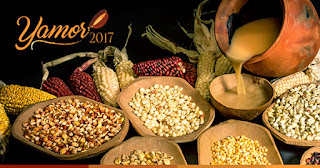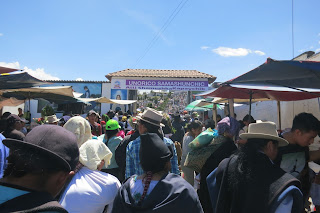Weaving Production Techniques: From Ancient to Modern in an Afternoon
Aka the day I
learned a TON about both ancient and current production methods. This day alone
makes my research feel worthwhile.
I went with one of
my contacts up the mountain behind her house in search of an “huso,” or
spindle. I originally misunderstood, and thought we were going to a location
that sold them; but no, we were going in search of a plant so we could collect
the proper stick. I learned that the “ancient spindle” is actually a stick from
the sicsi plant. The actual plant itself is a large, thin grass-like plant, but
the sticks on which the flowers grow are the important part. I never received
an answer why only sticks from the sicsi plant were used, rather than sticks
from other plants/trees. I suspect that it has to do with the sicsi sticks
being naturally smooth (and thus, they wouldn’t snag the yarn or cause debris
to enter the yarn), but I’ll have to do some more digging. The research never
ends.
After returning
with the stick, I still wasn’t convinced we had the right thing. I showed the
mom (who “knows all of the old ways” according to her daughters and just about
everyone else I talk to; this family is pretty well-known among locals for
being the only family (or at least one of the only families) to still weave on
a wooden floor loom, rather than a machinated one) the picture I had taken at
Peguche Wasi and asked if she could explain how the stick was used to spin yarn
(thinking maybe it was used for something else or was a different method of
spinning altogether). Nope, I should’ve had a little more faith.
In order to spin,
one needs the sicsi stick, as well as a longer stick that looks like bamboo (I
didn’t get the name, but I’ll ask). The diameter and the length of the sicsi
depend on the spinner’s preference, and don’t affect the yarn that will be
produced. Once raw pure cotton wool has been cleaned and carded, it is wrapped
around the bamboo stick, which is held between one’s knees. The person then
twists the sicsi spindle in their right hand, while the left hand slowly feels
the wool in order to create a thread/yarn. This method requires a lot of time
and talent. There’s hardly anyone alive that still remembers this technique;
it’s even rare to find folks who know how to spin with the Spanish style wheel (below).
It’s more common to simply buy yarn than to spin it.
Items that are
handmade from start to finish demand a high price, and nearly no one is willing
to pay it. For better or for worse, globalism has created tourists who expect
small, cheap items they can gift to the masses when they return home. They
either don’t recognize the time and talent that is required to produce a
completely handmade item, or they don’t care because it doesn’t suit their
desires. It’s next to impossible for folks to survive by making handmade items;
they simply can’t compete with mechanized production that mass-produces items (both
here and those that are imported and resold in the Plaza de Ponchos) that can
be sold much cheaper. However, I learned later in the day that there’s always a
tradeoff, and the grass isn’t necessarily greener; it just has different weeds.
Also while on the
mountain with Matilde, I learned more about penca, cabuya, and shigra.
The penca plant looks a lot like an agave plant, but apparently its
spines are somewhat different as are the small spikes along the edges of the
spikes. I’m not a biologist, so I’ll just accept that as the truth. From the
penca plant, one can split the spine open and peel the fiber down the length of
the spine to produce a thread, called cabuya. Rather than tying various
fibers together to create a longer thread or a sort of ball of yarn, artisans
who work with cabuya simply use the length of the fiber up and then move on to
the next thread. Because of this, it is better to obtain “thread” from the
bigger, taller plants, which produce longer fibers naturally. Once one has
collected the fibers, they are soaked in warm water to remove the natural green
hue. After soaking, they become a white fiber that can be dyed different colors
and woven into bags. A certain style of cylindrical open-top bags/purses made
from cabuya are called shigra [bags]. However, because this style of bag
is growing increasingly popular, many artisans have started weaving these bags
with acrylic yarns, rather than cabuya fibers. One can fairly easily tell by
looking and touching the bags: cabuya fibers can be dyed to nearly any color,
but they almost always look more earthen in their tones and they are a rougher
texture than those made of acrylic yarn. Tip: if it’s brightly colored and
smooth to the touch, it’s made from acrylic yarn. If you’re a purist and you’d
rather support the artisans who work with this older form of knowledge, keep
looking. Oddly, shigra bags cost around the same amount whether they are made
from acrylic yarn or cabuya fibers, which certainly takes more time and skill
to work with.
I’ve talked about
the old; now, here’s the new. After learning about the spindle, I visited two
other houses where I observed machinated textile production. At the first house,
I saw how the brightly colored acrylic tablecloths are made on electric looms,
and at the second house, I saw how acrylic bags are made and embroidered. While
at their houses, I realized how much space is required for this type of
production to house the machines and for storage of raw materials as well as
finished goods. I’d wager that what one gains in time is sacrificed in the
money spent on space, supplies, electricity, and labor. Additionally, the
owners of these machines/small-scale factories have a lot invested in their
methods of production, meaning they need to sell a lot of items in order to
yield a return. True, these items are cheaper than handmade items, but that
likely means they need to sell more items daily to cover their expenses. Also,
it’s quite common for small-scale factory owners to only sell in the market on Wednesdays
and Saturdays, allowing them to work in production the other days. While one
could argue this is an efficient use of their time, it still only gives them 2
days/week to make sales necessary for economic returns. It would be easy to “lose
money” by collecting a surplus of items based on the constant production. This is
why many producers sell to other local vendors; even if they don’t sell to
tourists daily, they still have an opportunity to make money. Additionally,
while machinated production doesn’t necessarily draw on historical production knowledge,
it still requires skill and some specialization to know how to use the machines
(and sometimes computers) to create different designs. Young men seem the most
likely to fill these roles as semi-skilled laborers, while it is not uncommon
for a middle-aged married couple to be the owners of the factory. As I said
above: there’s always a tradeoff, and the grass isn’t necessarily greener; it
just has different weeds.
Embroidery is done incredibly efficiently on this machine that has two heads capable of working simultaneously to create different designs, if so desired. It's controlled by a computer that uses a super user-friendly program that lets you easily change the size of the design, the color of thread for each individual letter if you want, and so much more!
Large-scale warping is just so much...bigger! These plastic cards tell the machines what designs to create, based on the holes punched out of them, like Scantron keys for weaving. These are used on machinated looms that don't have computers controlling them.
Standing at one end of the building, looking toward the far end, you can see how much space is required for machinated production. This building doesn't even house all of the production. They are also considering adding on to the building to accommodate an additional machine that would allow them to complete the process from start to finish entirely on the premises (right now, they have to send items out to be screen-printed, and are considering doing that in-house, as well, to have more control over the schedule/timeline).
















Comments
Post a Comment